MBA Dissertation: Cape Town Restaurant - Business and Marketing Plan
VerifiedAdded on 2023/06/15
|10
|908
|457
Dissertation
AI Summary
This MBA dissertation presents a comprehensive business and marketing plan for The Cape Town Restaurant. It includes an analysis of potential markets through consumer segmentation, purchase situation analysis, and direct competition analysis. A SWOT analysis identifies the restaurant's strengths, weaknesses, opportunities, and threats, informing business activities such as market research, business structure adoption, and marketing plan development. The dissertation outlines a framework for managing the business, including an organizational chart and cash flow statement, and details a marketing plan encompassing product/service analysis, situational analysis, goal definition, marketing strategies, implementation, and control evaluation. The plan aims to guide the restaurant in achieving its business objectives and targets.

MBA Dissertation
The Cape Town Restaurant
The Cape Town Restaurant
Paraphrase This Document
Need a fresh take? Get an instant paraphrase of this document with our AI Paraphraser
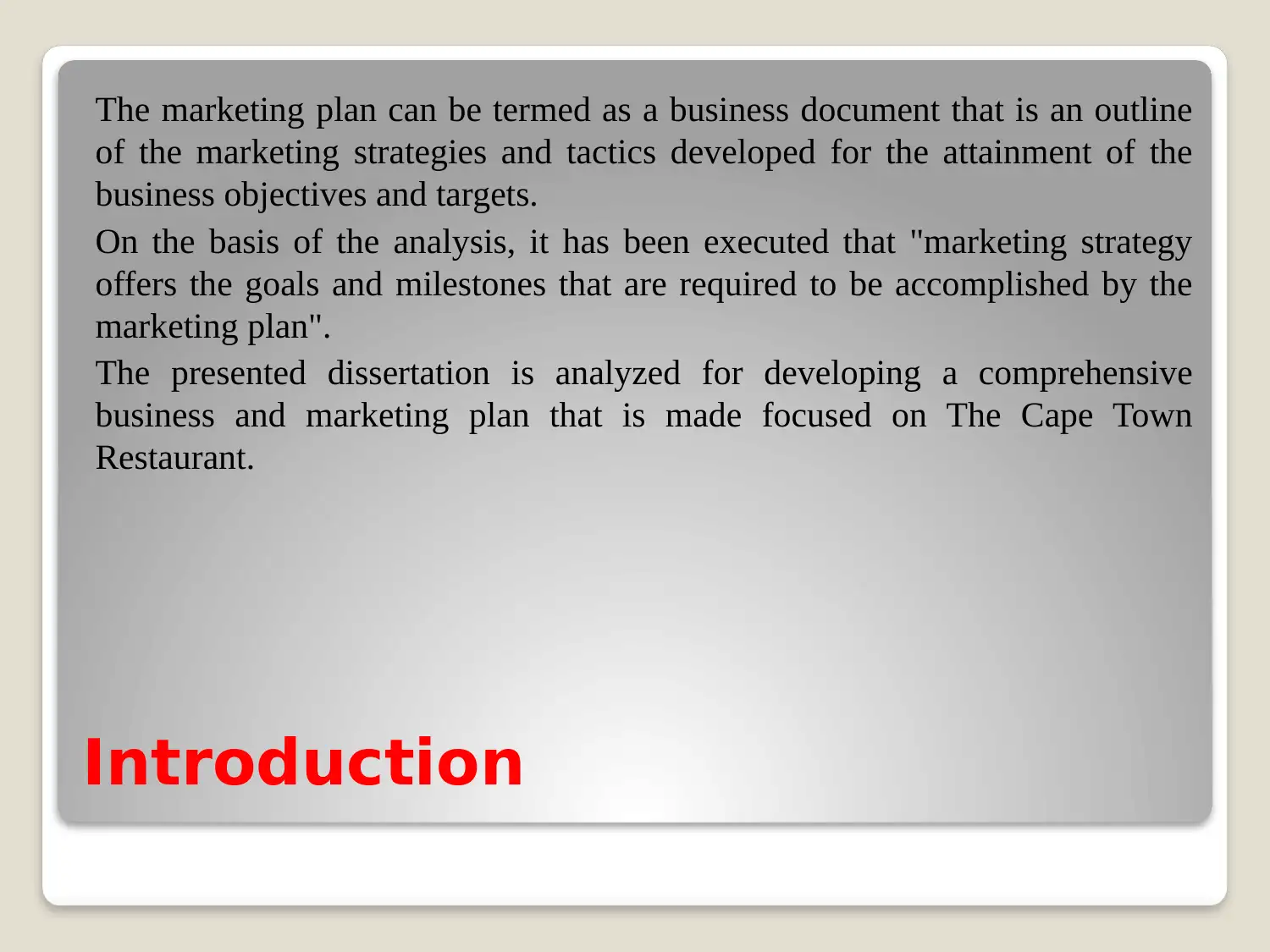
Introduction
The marketing plan can be termed as a business document that is an outline
of the marketing strategies and tactics developed for the attainment of the
business objectives and targets.
On the basis of the analysis, it has been executed that "marketing strategy
offers the goals and milestones that are required to be accomplished by the
marketing plan".
The presented dissertation is analyzed for developing a comprehensive
business and marketing plan that is made focused on The Cape Town
Restaurant.
The marketing plan can be termed as a business document that is an outline
of the marketing strategies and tactics developed for the attainment of the
business objectives and targets.
On the basis of the analysis, it has been executed that "marketing strategy
offers the goals and milestones that are required to be accomplished by the
marketing plan".
The presented dissertation is analyzed for developing a comprehensive
business and marketing plan that is made focused on The Cape Town
Restaurant.

Identification of Potential Markets
The below presented is the eight analysis approach that can be adopted by
The Cape Town Restaurant for identifying the market opportunities
Segmentation of consumers
Analysis of purchase situation (Abidi et al., 2015)
Direct competition analysis
Balancing products and services analysis
Analyzing other industries
The below presented is the eight analysis approach that can be adopted by
The Cape Town Restaurant for identifying the market opportunities
Segmentation of consumers
Analysis of purchase situation (Abidi et al., 2015)
Direct competition analysis
Balancing products and services analysis
Analyzing other industries
⊘ This is a preview!⊘
Do you want full access?
Subscribe today to unlock all pages.

Trusted by 1+ million students worldwide
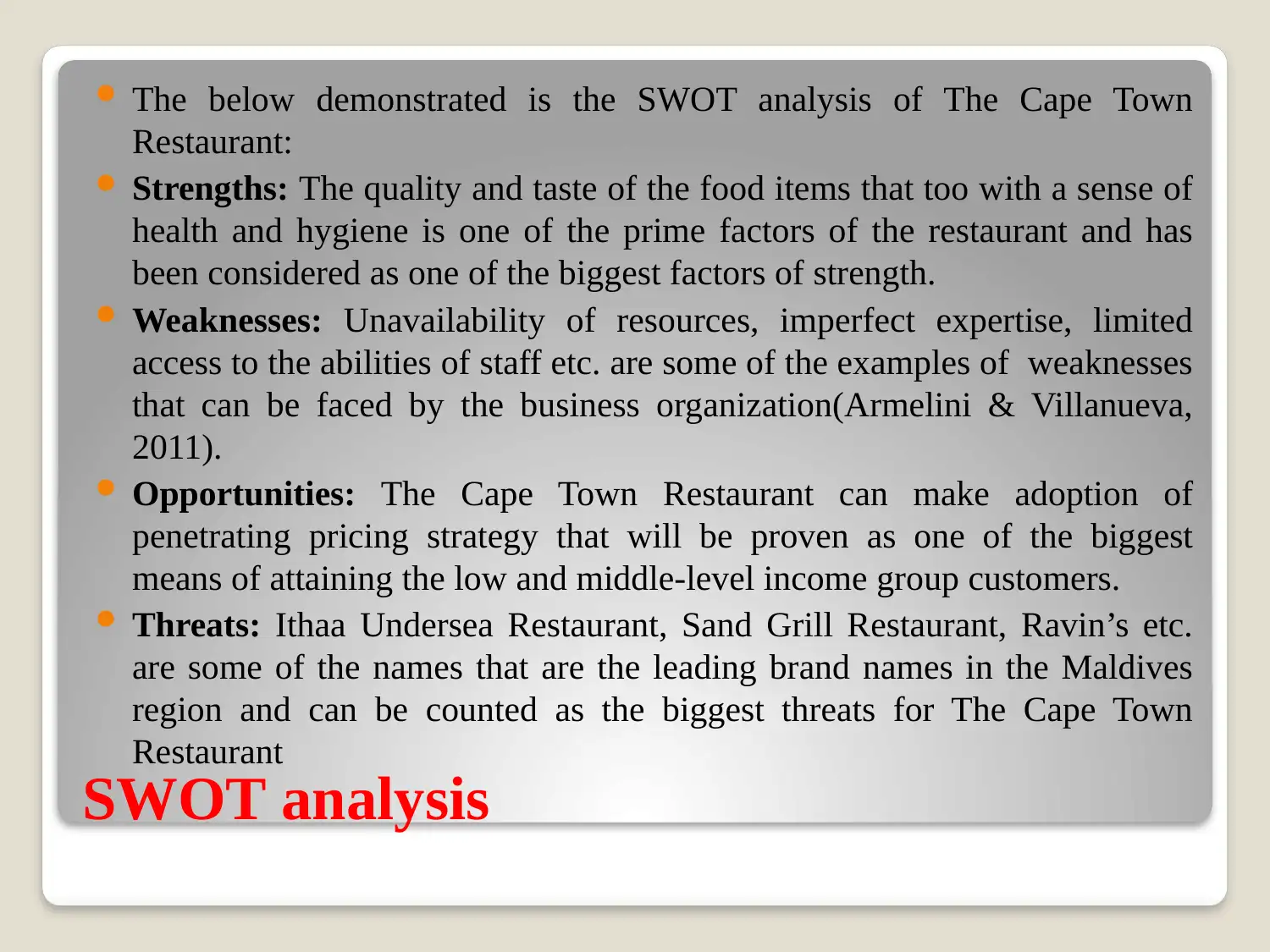
SWOT analysis
The below demonstrated is the SWOT analysis of The Cape Town
Restaurant:
Strengths: The quality and taste of the food items that too with a sense of
health and hygiene is one of the prime factors of the restaurant and has
been considered as one of the biggest factors of strength.
Weaknesses: Unavailability of resources, imperfect expertise, limited
access to the abilities of staff etc. are some of the examples of weaknesses
that can be faced by the business organization(Armelini & Villanueva,
2011).
Opportunities: The Cape Town Restaurant can make adoption of
penetrating pricing strategy that will be proven as one of the biggest
means of attaining the low and middle-level income group customers.
Threats: Ithaa Undersea Restaurant, Sand Grill Restaurant, Ravin’s etc.
are some of the names that are the leading brand names in the Maldives
region and can be counted as the biggest threats for The Cape Town
Restaurant
The below demonstrated is the SWOT analysis of The Cape Town
Restaurant:
Strengths: The quality and taste of the food items that too with a sense of
health and hygiene is one of the prime factors of the restaurant and has
been considered as one of the biggest factors of strength.
Weaknesses: Unavailability of resources, imperfect expertise, limited
access to the abilities of staff etc. are some of the examples of weaknesses
that can be faced by the business organization(Armelini & Villanueva,
2011).
Opportunities: The Cape Town Restaurant can make adoption of
penetrating pricing strategy that will be proven as one of the biggest
means of attaining the low and middle-level income group customers.
Threats: Ithaa Undersea Restaurant, Sand Grill Restaurant, Ravin’s etc.
are some of the names that are the leading brand names in the Maldives
region and can be counted as the biggest threats for The Cape Town
Restaurant
Paraphrase This Document
Need a fresh take? Get an instant paraphrase of this document with our AI Paraphraser
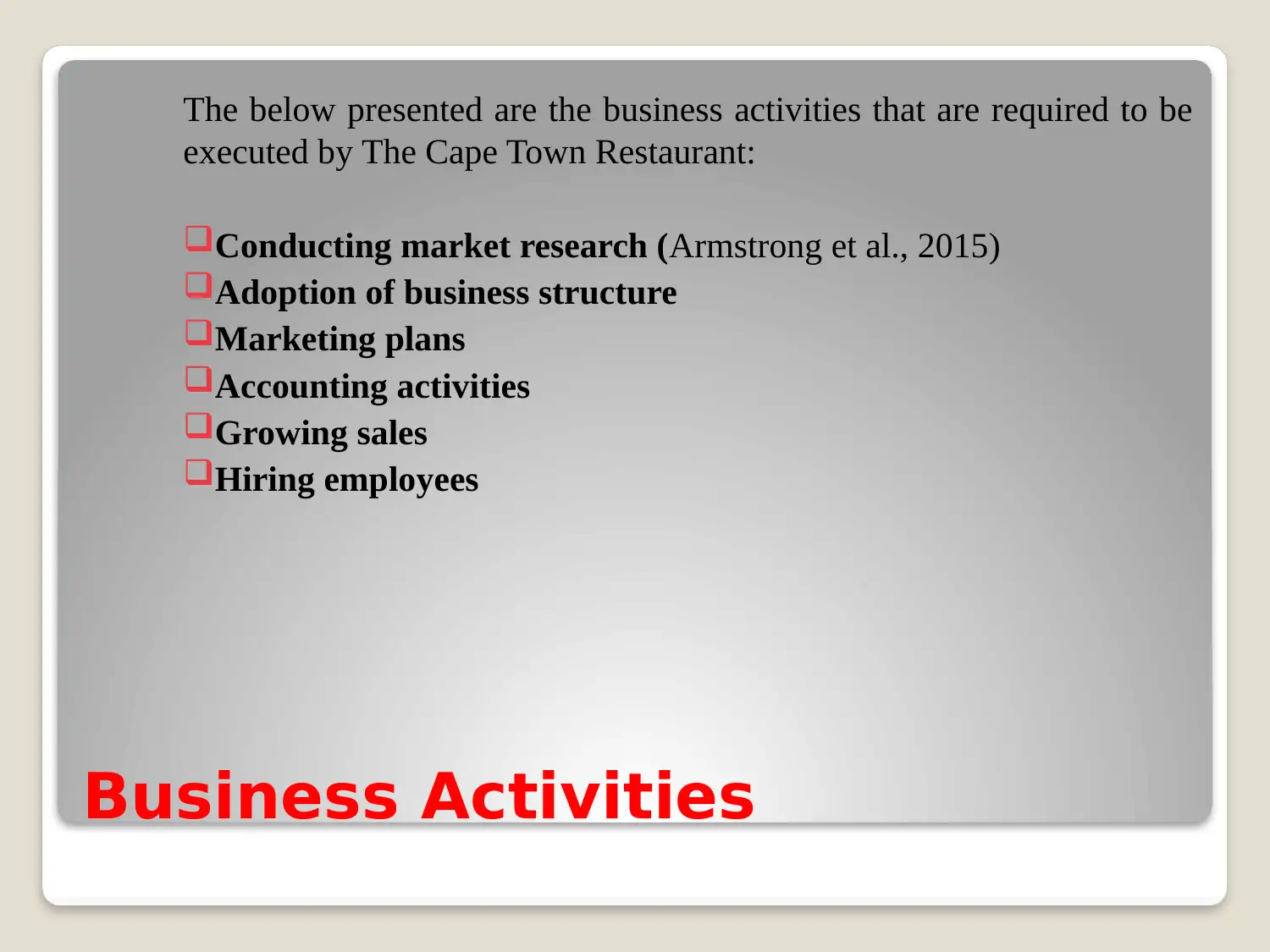
Business Activities
The below presented are the business activities that are required to be
executed by The Cape Town Restaurant:
Conducting market research (Armstrong et al., 2015)
Adoption of business structure
Marketing plans
Accounting activities
Growing sales
Hiring employees
The below presented are the business activities that are required to be
executed by The Cape Town Restaurant:
Conducting market research (Armstrong et al., 2015)
Adoption of business structure
Marketing plans
Accounting activities
Growing sales
Hiring employees
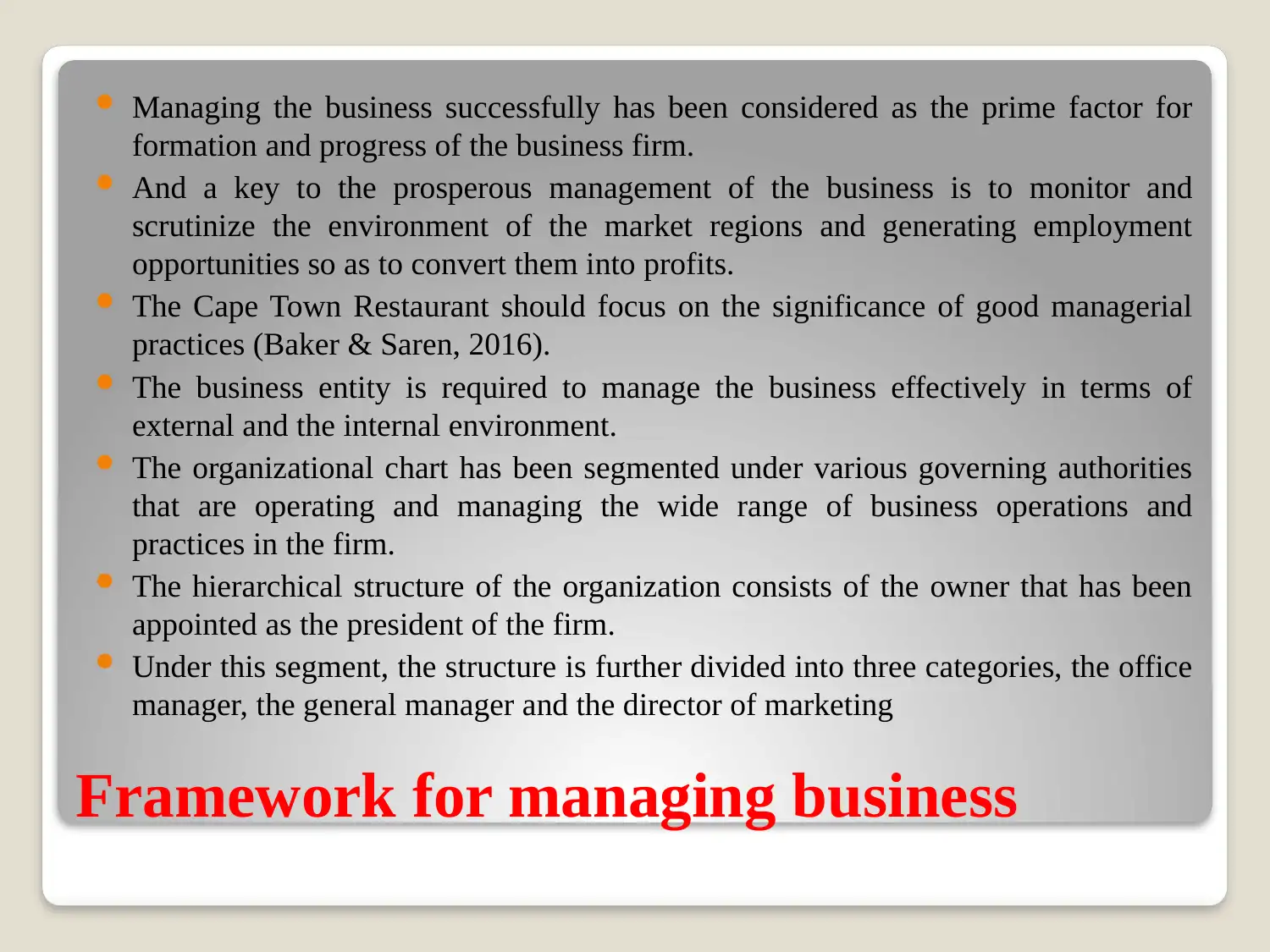
Framework for managing business
Managing the business successfully has been considered as the prime factor for
formation and progress of the business firm.
And a key to the prosperous management of the business is to monitor and
scrutinize the environment of the market regions and generating employment
opportunities so as to convert them into profits.
The Cape Town Restaurant should focus on the significance of good managerial
practices (Baker & Saren, 2016).
The business entity is required to manage the business effectively in terms of
external and the internal environment.
The organizational chart has been segmented under various governing authorities
that are operating and managing the wide range of business operations and
practices in the firm.
The hierarchical structure of the organization consists of the owner that has been
appointed as the president of the firm.
Under this segment, the structure is further divided into three categories, the office
manager, the general manager and the director of marketing
Managing the business successfully has been considered as the prime factor for
formation and progress of the business firm.
And a key to the prosperous management of the business is to monitor and
scrutinize the environment of the market regions and generating employment
opportunities so as to convert them into profits.
The Cape Town Restaurant should focus on the significance of good managerial
practices (Baker & Saren, 2016).
The business entity is required to manage the business effectively in terms of
external and the internal environment.
The organizational chart has been segmented under various governing authorities
that are operating and managing the wide range of business operations and
practices in the firm.
The hierarchical structure of the organization consists of the owner that has been
appointed as the president of the firm.
Under this segment, the structure is further divided into three categories, the office
manager, the general manager and the director of marketing
⊘ This is a preview!⊘
Do you want full access?
Subscribe today to unlock all pages.

Trusted by 1+ million students worldwide
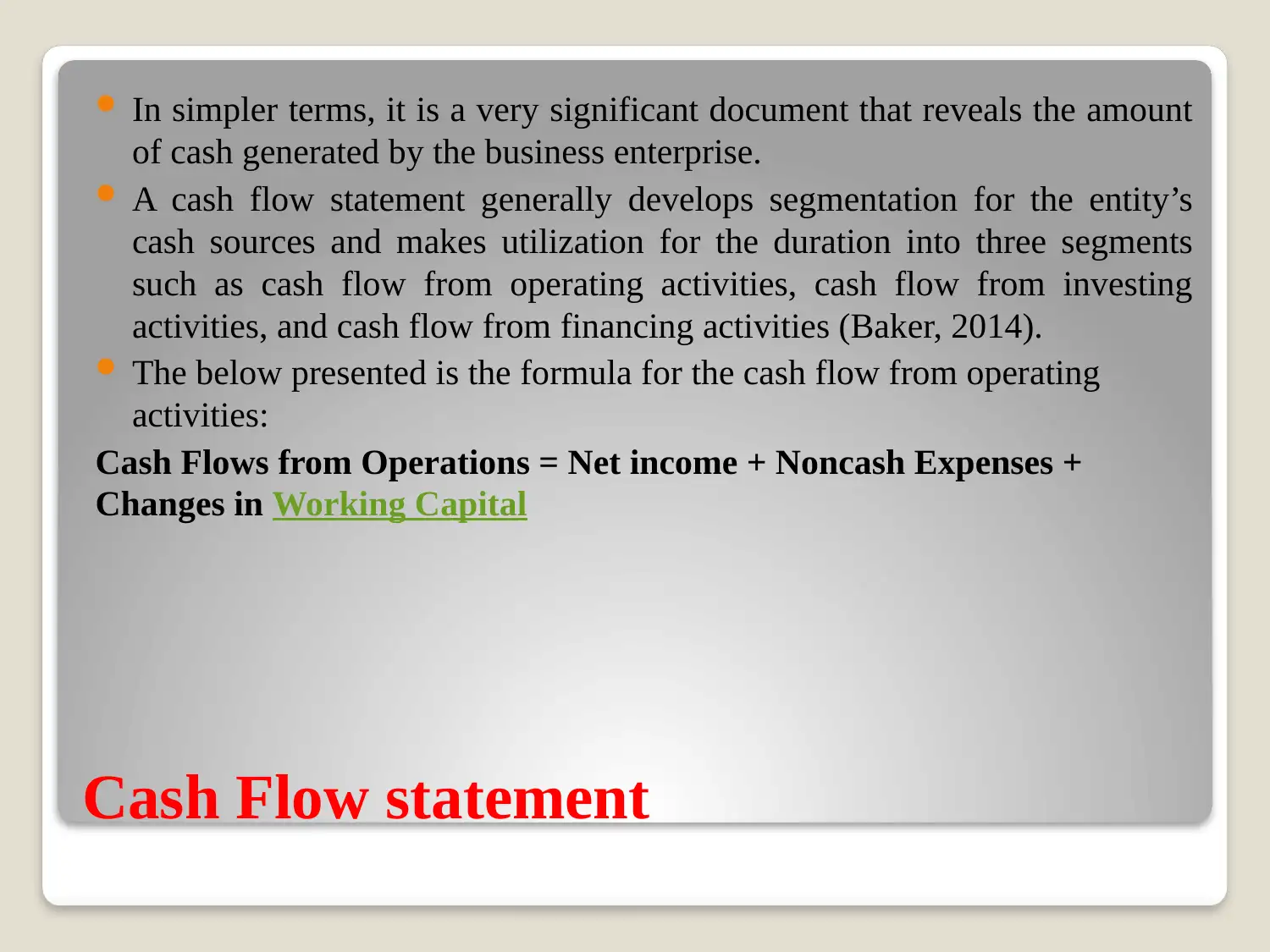
Cash Flow statement
In simpler terms, it is a very significant document that reveals the amount
of cash generated by the business enterprise.
A cash flow statement generally develops segmentation for the entity’s
cash sources and makes utilization for the duration into three segments
such as cash flow from operating activities, cash flow from investing
activities, and cash flow from financing activities (Baker, 2014).
The below presented is the formula for the cash flow from operating
activities:
Cash Flows from Operations = Net income + Noncash Expenses +
Changes in Working Capital
In simpler terms, it is a very significant document that reveals the amount
of cash generated by the business enterprise.
A cash flow statement generally develops segmentation for the entity’s
cash sources and makes utilization for the duration into three segments
such as cash flow from operating activities, cash flow from investing
activities, and cash flow from financing activities (Baker, 2014).
The below presented is the formula for the cash flow from operating
activities:
Cash Flows from Operations = Net income + Noncash Expenses +
Changes in Working Capital
Paraphrase This Document
Need a fresh take? Get an instant paraphrase of this document with our AI Paraphraser

The marketing plan is an official document or a process through which the business
entity makes the promotion of the products and services offered by the business firm
(Bayne, Schepis & Purchase, 2017).
The major objective of developing this plan is to promote and market the services
offered by the business firm
Product/service analysis
Situational analysis
Internal analysis
External analysis
Defining goals and objectives
Marketing strategies
Implementation plan
Control and evaluation
entity makes the promotion of the products and services offered by the business firm
(Bayne, Schepis & Purchase, 2017).
The major objective of developing this plan is to promote and market the services
offered by the business firm
Product/service analysis
Situational analysis
Internal analysis
External analysis
Defining goals and objectives
Marketing strategies
Implementation plan
Control and evaluation
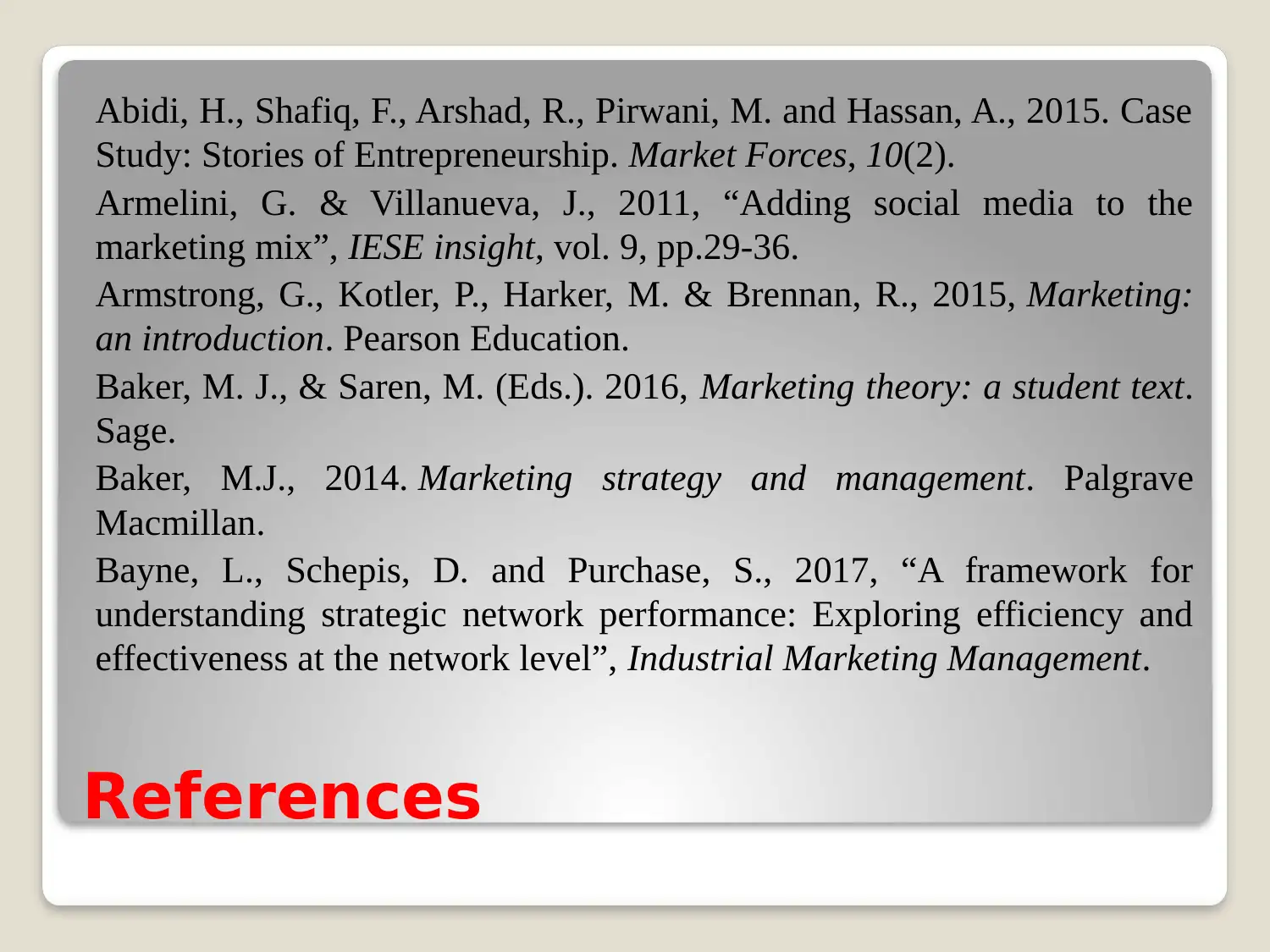
References
Abidi, H., Shafiq, F., Arshad, R., Pirwani, M. and Hassan, A., 2015. Case
Study: Stories of Entrepreneurship. Market Forces, 10(2).
Armelini, G. & Villanueva, J., 2011, “Adding social media to the
marketing mix”, IESE insight, vol. 9, pp.29-36.
Armstrong, G., Kotler, P., Harker, M. & Brennan, R., 2015, Marketing:
an introduction. Pearson Education.
Baker, M. J., & Saren, M. (Eds.). 2016, Marketing theory: a student text.
Sage.
Baker, M.J., 2014. Marketing strategy and management. Palgrave
Macmillan.
Bayne, L., Schepis, D. and Purchase, S., 2017, “A framework for
understanding strategic network performance: Exploring efficiency and
effectiveness at the network level”, Industrial Marketing Management.
Abidi, H., Shafiq, F., Arshad, R., Pirwani, M. and Hassan, A., 2015. Case
Study: Stories of Entrepreneurship. Market Forces, 10(2).
Armelini, G. & Villanueva, J., 2011, “Adding social media to the
marketing mix”, IESE insight, vol. 9, pp.29-36.
Armstrong, G., Kotler, P., Harker, M. & Brennan, R., 2015, Marketing:
an introduction. Pearson Education.
Baker, M. J., & Saren, M. (Eds.). 2016, Marketing theory: a student text.
Sage.
Baker, M.J., 2014. Marketing strategy and management. Palgrave
Macmillan.
Bayne, L., Schepis, D. and Purchase, S., 2017, “A framework for
understanding strategic network performance: Exploring efficiency and
effectiveness at the network level”, Industrial Marketing Management.
⊘ This is a preview!⊘
Do you want full access?
Subscribe today to unlock all pages.

Trusted by 1+ million students worldwide

1 out of 10
Related Documents
Your All-in-One AI-Powered Toolkit for Academic Success.
+13062052269
info@desklib.com
Available 24*7 on WhatsApp / Email
![[object Object]](/_next/static/media/star-bottom.7253800d.svg)
Unlock your academic potential
Copyright © 2020–2025 A2Z Services. All Rights Reserved. Developed and managed by ZUCOL.





